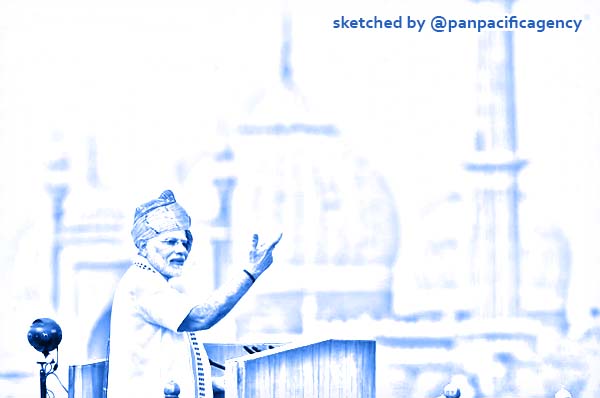India’s GDP growth falls to 4.5 per cent in Q2 of 2019-2020

Prime Minister Narendra Modi speaking on Independence Day at the Red Fort in Delhi (India Today). Sketched by the Pan Pacific Agency.
NEW DELHI, Nov 30, 2019, India Today. India’s Gross Domestic Product continued its downward spiral for the seventh consecutive quarter, falling to 4.5 per cent in the second quarter (July-September) of the year 2019-20. This is a fall of 0.5 per cent points compared to the last quarter. Compared to the second quarter of the year 2018-19, it is a fall of 2.6 per cent points. In the second quarter of the previous year, the GDP growth stood at 7.1 per cent, India Today reported.
The GDP growth seen in the last quarter was slowest in more than six years. The previous low was recorded at 4.3 per cent in the final quarter (January-March) of 2012-13.
The GDP numbers were released along with the data for the eight core infrastructure industries, which showed output delcining by 5.8 per cent in October. As many as six of eight core industries saw a contraction in output in October. Coal was the worst hit, declining steeply by 17.6 per cent.
The GDP numbers for the July-September quarter today come after six consecutive quarters of falling GDP growth rate. The GDP growth rate for the first quarter of 2019-20 settled at 5 per cent, a six-year low. The slowdown in economic growth has taken away from India the tag of world’s fastest growing major economy to China. India’s growth rates in the Q4 2018-19 and Q1 2019-20 were slower than that of China, which is a much bigger economy.
India’s economic growth has taken a hit due to a number of factors – including slowdown in private consumption, investment and export – but the key indicator is lack of credit (money to produce goods) growth and demand in the market. The Narendra Modi government has taken a slew of reforms in recent months to boost credit in the market – focusing on offering incentives to banks to increase lending – but to little avail.
These measures include slashing of the lending rate (the rate that is linked to banks’ interest rates) by the Reserve Bank of India five times this year, withdrawal of ‘super-rich surcharge’ imposed on foreign investors, exemption of start-ups from ‘angel tax’, an infusion of Rs 70,000 crore in public sector banks and a significant cut in the corporate tax rate.
However, analysts and experts were of the view that the government did not do enough to address the issue of slowdown in demand. They argued that declining demand is among the prime reasons for economic slowdown.
The concern expressed by economists is in sync with what Union Finance Minister Nirmala Sitharaman said earlier this month. She had ruled out revival of economy any time soon while asserting that the government was doing everything possible.
“It is too presumptive of me to say it [economic slowdown] has bottomed out,” Sitharaman had said speaking to reporters earlier this month, fueling speculation that India’s economy is yet to see the worst of the ongoing downturn.